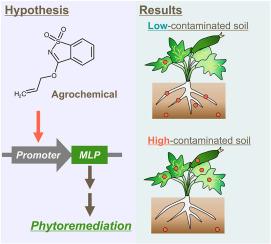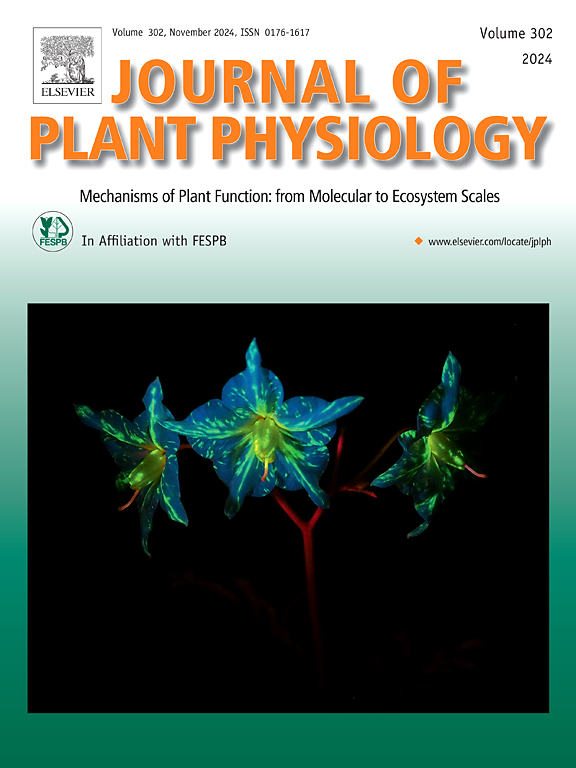农化oryzed处理能否通过调节主要的乳胶样蛋白来控制葫芦类植物对芘的吸收?
IF 4
3区 生物学
Q1 PLANT SCIENCES
引用次数: 0
摘要
葫芦科植物在其地上部分积聚了高浓度的几种疏水性有机污染物。在葫芦中发现的主要乳胶样蛋白(MLPs)与根中的疏水性有机污染物(如芘和狄氏剂)结合,形成复合物,通过木质部导管运输到植物的地上部分。然而,利用mlp修复疏水性有机污染物的研究尚未建立。在本研究中,农化处理后,通过上调MLP基因的表达,促进了C. pepo对疏水性有机污染物芘的吸收。丙苯唑是农用化学品Oryzemate中的一种活性成分,以前发现它可以上调转基因烟草植株根中MLP基因的启动子活性。本研究表明,orryate处理增加了C. pepo根和木质部汁液中MLPs的水平。在高污染土壤和低污染土壤中,黑麦草木质部汁液中芘的浓度分别略有增加和显著降低。在体外,苯丙唑竞争性地抑制了MLPs与芘的结合,从而可能抑制了低污染土壤中C.人对芘的吸收。本研究表明,根据土壤污染程度的不同,Oryzemate具有有效的植物修复和安全作物生产的双重作用。本文章由计算机程序翻译,如有差异,请以英文原文为准。

Can the agrochemical Oryzemate treatment control the uptake of pyrene by Cucurbita pepo through the regulation of major latex-like proteins?
Members of the Cucurbitaceae family accumulate several hydrophobic organic pollutants in their above-ground parts at high concentrations. Major latex-like proteins (MLPs) identified in Cucurbita pepo bind to hydrophobic organic pollutants, such as pyrene and dieldrin, in roots, forming complexes that are transported via xylem vessels to the above-ground plant parts. However, soil remediation of hydrophobic organic pollutants utilizing MLPs has not been established. In this study, the uptake of the hydrophobic organic pollutant pyrene by C. pepo was promoted through the upregulation of the expression of MLP genes following agrochemical treatment. Probenazole, an active ingredient in the agrochemical Oryzemate, was previously found to upregulate the promoter activity of MLP genes in the roots of transgenic tobacco plants. Here, Oryzemate treatment increased the levels of MLPs in the roots and xylem sap of C. pepo. Oryzemate treatment slightly increased and significantly decreased the pyrene concentration in the xylem sap of C. pepo cultivated in high- and low-contamination soils, respectively. Probenazole competitively inhibited the binding of MLPs to pyrene in vitro, thereby likely suppressing its uptake by C. pepo in low-contamination soil. This study demonstrated that Oryzemate possesses dual effects: effective phytoremediation and safe crop production, depending on the soil contamination level.
求助全文
通过发布文献求助,成功后即可免费获取论文全文。
去求助
来源期刊

Journal of plant physiology
生物-植物科学
CiteScore
7.20
自引率
4.70%
发文量
196
审稿时长
32 days
期刊介绍:
The Journal of Plant Physiology is a broad-spectrum journal that welcomes high-quality submissions in all major areas of plant physiology, including plant biochemistry, functional biotechnology, computational and synthetic plant biology, growth and development, photosynthesis and respiration, transport and translocation, plant-microbe interactions, biotic and abiotic stress. Studies are welcome at all levels of integration ranging from molecules and cells to organisms and their environments and are expected to use state-of-the-art methodologies. Pure gene expression studies are not within the focus of our journal. To be considered for publication, papers must significantly contribute to the mechanistic understanding of physiological processes, and not be merely descriptive, or confirmatory of previous results. We encourage the submission of papers that explore the physiology of non-model as well as accepted model species and those that bridge basic and applied research. For instance, studies on agricultural plants that show new physiological mechanisms to improve agricultural efficiency are welcome. Studies performed under uncontrolled situations (e.g. field conditions) not providing mechanistic insight will not be considered for publication.
The Journal of Plant Physiology publishes several types of articles: Original Research Articles, Reviews, Perspectives Articles, and Short Communications. Reviews and Perspectives will be solicited by the Editors; unsolicited reviews are also welcome but only from authors with a strong track record in the field of the review. Original research papers comprise the majority of published contributions.
 求助内容:
求助内容: 应助结果提醒方式:
应助结果提醒方式:


